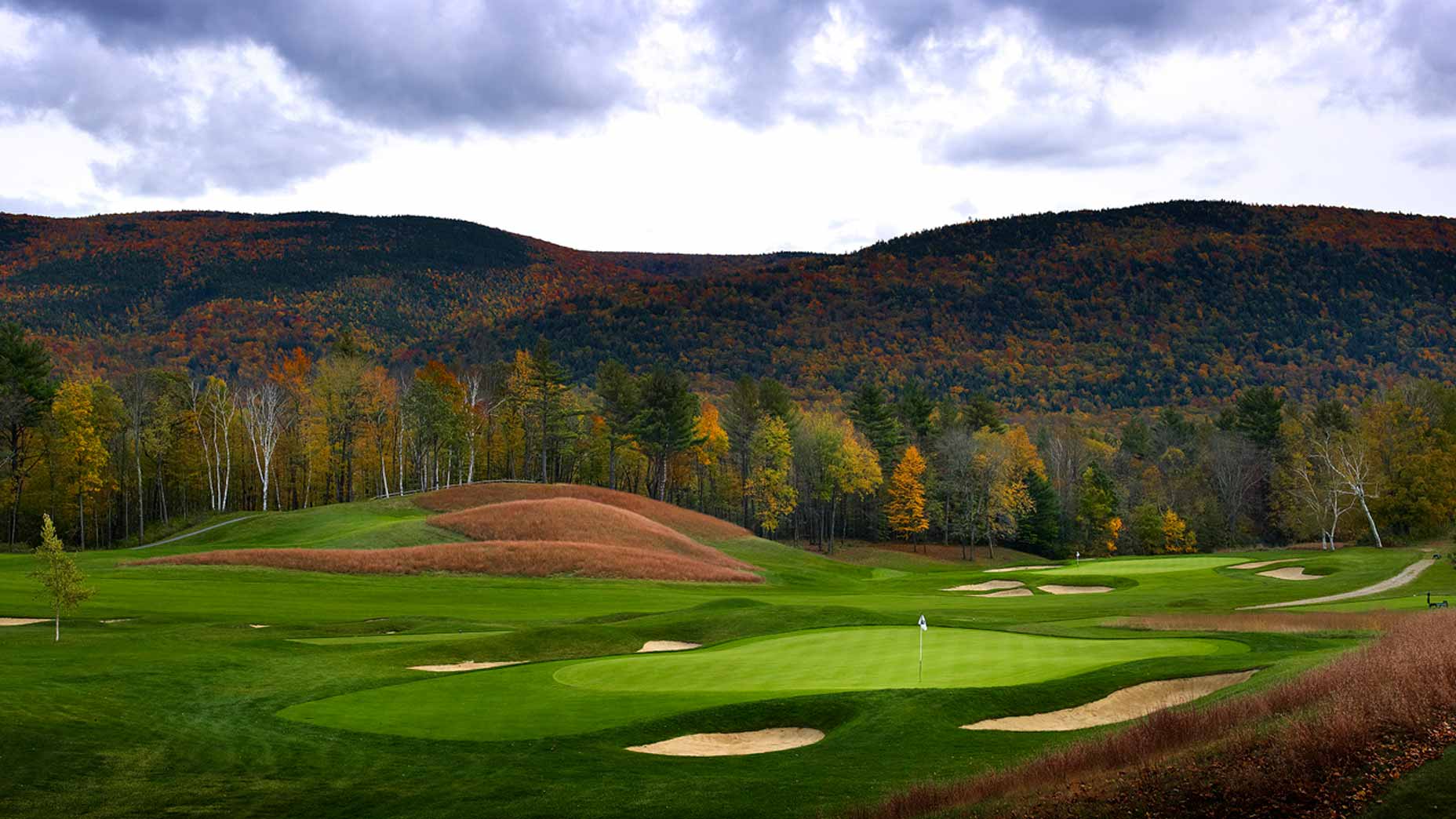Why rank golf courses? Well, because we love a good 19th-hole debate. We love to make bucket lists. We love to track trends in the sport. We love to know which architects are hot (or not). And nothing spurs healthy discourse about golf course architecture more than a good list.
For these reasons and plenty others, we at GOLF think Top 100 lists are important, so the responsibility is acute to do the best job we can with them. For that, we rely on our panel of design aficionados — 127 of them scattered across the globe. Their handicaps range from +5 to 15. There’s a 52-year gap between our youngest and oldest panelist. Some have teed it up at over 2,000 courses, others at merely several hundred. Because the nature of course rating is so intensely subjective, no one opinion carries the day. The only way, then, to build meaningful consensus is to incorporate this diversity of panelists and experiences into one ranking.
Welcome back
The star of the show — our mainstay U.S. list, which we publish every two years — is, as always, a road map to where course design is headed and, in the case of several high-profile restorations, where it’s been. Of the 11 new entries in our 2024-25 ranking of the Top 100 Courses in the U.S., four of them — Interlachen (No. 73), Medinah #3 (No. 74), Fox Chapel (No. 82) and Philadelphia Cricket (No. 98) — are making their return to the list, driven by successful restorations.
The biggest mover is the venerable Medinah #3, coming in a remarkable 109 spots higher than it did in our 2022-23 list, an unheard-of leap inspired by the sensational work of the Australian design firm Ogilvy, Cocking and Mead (OCM). Founded in 1924, Medinah CC always intended for great things to take place there, but hosting championship golf — three U.S. Opens, two PGAs, a Ryder Cup — is fraught with peril. Over the decades, a half dozen architects had a say in Course #3’s evolution, with the general ambition being to make it longer, harder — and narrower. Ultimately, its Golden Age roots and panache, established by Tom Bendelow from 1928 through 1932, were compromised. Not unlike what took place at Congressional a few years back, the Medinah board decided a reboot was in order and that unifying the course under one hand — and returning it to its Golden Age ethos — was paramount. In 2020, the usual suspects in the States were contacted. In addition, the Green Committee reached out to OCM, whose restoration proposal turned out to be awe-inspiring, meaning just that — it elicited awe from the club.

Working from vintage black-and-white photographs taken in 1937 at the Medinah-hosted Chicago Open — images that showed a dramatic and boldly bunkered, open and expansive course — OCM set about reconfiguring five holes, none more daringly and brilliantly than the dogleg-right 16th, with its classic Cape attributes and carry over Lake Kadijah. Elsewhere, they added a split rail fence that runs snug down the left side of holes 5 through 7, the strategy of all three impacted exquisitely by this out-of-bounds tension.
OCM’s work is a triumph at every level. While remaining a fit test for the game’s best, Course #3 is more handsome, strategic and exciting than it’s ever been.
GOLF’s other course rankings: Top 100 Courses in the World | Top 100 Courses You Can Play | Top 100 Value Courses in the U.S. | America’s Best Municipal Courses | Top 100 in the U.K. and Ireland | Top 100 Short Courses in the World
New builds
Of the seven other courses to crack our 2024 ranking, four are builds that have opened since our last U.S. list: The Lido (No. 30), Old Barnwell (No. 51), Ladera (No. 87) and Pinehurst No. 10 (No. 88). Given that The Lido had its coming out at No. 68 on our 2023-24 list of the Top 100 Courses in the World, its lofty debut here was a foregone conclusion. Joining the list with a bang is Old Barnwell, located outside of Aiken, S.C. (It’s worth noting that the co-architect at The Lido, Brian Schneider, is also the co-architect at Old Barnwell.) Readers often ask why certain courses fare better than others. The answer is so straightforward some people doubt it. Relating to Old Barnwell, it vaulted into the Top 100 because it racked up loads of high votes and had few detractors. Panelists have drawn the same conclusion: The course is a thrilling blend of challenge, strategy and fun. That’s the Holy Grail of design, but how, specifically, does Old Barnwell achieve it?

Let’s break down its dogleg-left, par-4 10th, a microcosm of the course’s excellence: From the tee, its fairway looks innocuously wide, but it is slightly crowned and feeds balls either left and into a string of unseen bunkers or right and farther away from the green. Though the green is open along its high right side, bunkers start at its front and trail around to the left. Skilled players strive to find the flattest part of the fairway’s 20-yard-wide crown, then hit an artfully drawn ball that lands just right of the green, takes the right-to-left slope and eases onto the open putting surface. The rest of us have gobs of short grass at our disposal to avoid the well-placed hazards. In short, every kind of golfer finds pleasure playing here.
Interestingly, Old Barnwell is located in the same vein of sand that starts some 170 miles to the northeast in Pinehurst, N.C., home of the new Pinehurst No. 10. This muscular Tom Doak design was run by his associate Angela Moser. Some guests of the resort are surprised by No. 10’s hilliness, but they shouldn’t be. Appropriately, this region is called “the Sandhills of North Carolina,” and Doak’s design steadfastly embraces it. But a legitimate surprise awaits at the 8th, where you have to launch your tee ball over a 30-foot-high landform dubbed the Matterhorn by Doak’s crew. This piece of the property was mined for sand nearly a century ago, and the hole requires negotiating rambunctious upheavals.
Ladera didn’t, per se, open to rollicking reviews earlier this year, because not many people get to play it. Founded by two California-based media and tech moguls, this ultra-exclusive private course, located in a remote lower region of Coachella Valley, looks as if it’s been there for decades. In part, that’s because the holes lay so naturally along the ground. It’s also because its native plantings of purple wildflowers and brittle yellow brush look long-established. Yet every inch of the property was manipulated by architects Gil Hanse and Jim Wagner. The result is something uncommonly beautiful, with a slew of standout holes. Ladera serves as the ultimate example of how far we’ve come in pushing and pulling land to make it look like we didn’t.
Nature, not nurture
Courses that enjoy spectacular natural features got a nice bump on this year’s list. Examples include CapRock Ranch (up 13 spots to No. 46), which plays along Nebraska’s Snake River valley some 550 feet below; Herbert Fowler’s figure-eight routing at Eastward Ho! (up 7 to No. 50), which takes maximum advantage of Cape Cod’s glacial moraine landforms; West Virginia’s Pikewood National (up 7 to No. 57), which plays on an escarpment that affords 35-mile views in the direction of Maryland; and Nanea (up 8 to No. 83), with holes that weave through Kailua-Kona’s captivating lava fields. Rest assured, these aren’t just beauty contests. The architecture at all four takes superb advantage of what nature offers. The same can be said for the first-time inclusion of Sankaty Head (No. 92), set by a lighthouse — the ultimate romance for some golfers — on the east end of Nantucket.

Renewals
Plenty of compelling golf is also found on sites not so richly endowed. One big mover is New Jersey’s Hollywood (up 14 spots to No. 75). Brian Schneider finished restoring this 1915 Walter Travis gem in 2022, when the club green-lighted the return of the original 17th green. Manmade features, in the form of elaborate bunkering schemes and imaginative green contours, wow lucky golfers — as is to be expected at a place whose name evokes glamour.
In the northern suburbs of Chicago, Old Elm (No. 94) is another architectural gem over modest terrain. Its high point — the infuriatingly knobbed 2nd green that Harry Colt placed on a hillock — is a gentle 60 feet higher than the property’s southern border low point. Guess who Colt’s Old Elm construction supervisor was in 1914-15? Donald Ross (or “Douglas” Ross, as he was once mistakenly referred to by Colt). This low-key Chi-town club has undergone quite the transformation in recent times, and its story highlights the importance of synergy between consulting architect and greenskeeper — in this case, David Zinkand and Curtis James.
James came to Old Elm in 2009 to restore Colt’s course. He began plucking away at poorly situated trees and shut off water to the fairways in order to make the ground as firm as possible. When he inherited the course, there were 25 acres of short bentgrass. Now there are 63. This set the stage for Zinkand to painstakingly rebuild every single bunker to Colt’s 1913 specifications — and to do so at scale.

Highlights of the work include extensive 50-plus-yard-long cross hazards that slash into fairways in uncomfortable places. Colt bunkers have been added that Ross elected not to pursue. Short grass rings many greens. And given the firmness James routinely achieves, rounds here can feel like death by a thousand cuts for a good player, as you aren’t quite sure why shots continually bleed away. You won’t lose a ball, but it’s fascinating how two shots become three around these clever greens. Colt would be thrilled, and if there’s a firm and faster-playing original Colt design in the world, I haven’t seen it.
A final example of making the most of modest topography is Trinity Forest (No. 96), on the outskirts of Dallas. This intriguing Coore-Crenshaw design was, famously, built on an abandoned landfill. Apart from their Texas roots, why did the duo even consider such a project? Before they walked the raw property with its founder Jonas Woods, they asked for it to be mowed. Exposed was a field of two- to four-foot random undulations, the result of an uneven settling of the turf. In its way, the unassuming parcel shared qualities with the game’s most hallowed rumpled landscape, the Old Course at St. Andrews. Nothing was overtly dramatic, but the best golf is often human-size in scale. Coore and Crenshaw envisioned a bouncy, running course and complemented the uneven ground contours with one of their best sets of greens. In the spring and fall, tight-knit zoysia offers a surprisingly frictionless playing surface, and greenskeeper Kasey Kauff has balls humming along the fairways, making Trinity Forest a nirvana for those who love the ground game.
Three lenses
Our rankings, as we’ve said, are built on highly individual experiences. But do unique groups of our panelists — raters based outside of the States, for example, or course architects or plus-handicappers — think differently from our panel as a whole? We thought it’d be interesting to find out, so we viewed our ballots through those three lenses.
We learned the foreign panelist vote showed a strong affinity for Chicago GC and its august history, placing the course at No. 6 — six spots higher than its official place at No. 12 on the list. Palmetto GC, which just slipped out of our Top 100, also scored well with the overseas set — no surprise given that the culture and quaintness of this South Carolina club has as much of a UK vibe as any in the U.S. They also had North Carolina’s quirky Tobacco Road in their Top 100, appreciating its design uniqueness not only within the States but anywhere in the world. Most surprising was their lack of love for Pebble Beach. They knocked it down 10 spots, from its pedestal currently at No. 8 to No. 18. The grumblings were that, over time, Pebble’s greens have become too small for such a windblown site.

As for the architects, they showed a clear affinity for Donald Ross, placing four additional Ross courses into their Top 100: Wannamoisett, in Rhode Island; the Beverly, in Chicago; the Ross Course at French Lick, in Indiana; and Roaring Gap, in North Carolina. More than anyone, designers appreciate just how difficult it is to route a course, and there was none better at that tricky task than Ross.
Our architects also appreciate when great designs emerge from less than perfect sites. For instance, Winged Foot (West) (No. 18) made their Top 10, as they marveled at what A.W. Tillinghast was able to create over subdued landforms. Also, they had Virginia’s Cascades, which didn’t make our main Top 100 list, at No. 56. Tillinghast turned down the Cascades build, but William Flynn found a clever way to carve the holes into a narrow valley floor in the Allegheny Mountains.
Our architect panelists were also quick to applaud designs economical to both maintain and play, ranking Lawsonia (green fee: $110) as high as No. 44 and the elegant Wild Horse (green fee: $60), in Nebraska, at No. 85. Most newsworthy, they had — drumroll! — Cypress Point outdueling (by a whisker) Pine Valley for the No. 1 spot. Alister MacKenzie, sand dunes and the mighty Pacific Ocean make for an undeniably terrific combination.
Finally, plus-handicap panelists filed ballots that most closely resembled our final Top 100 Courses in the U.S. list. But they had Bandon Trails edging out Pacific Dunes, and had Colorado Golf Club, unranked in our Top 100, at No. 76. Colorado GC, with its prairie grasses and yucca plants, does place a premium on execution and thoughtful course management, something that clearly appeals to those who can hit the ball where they want.











